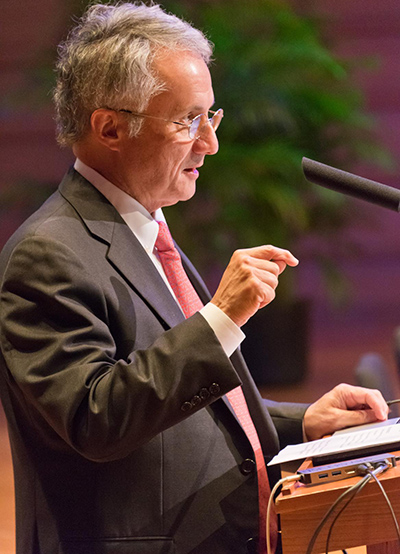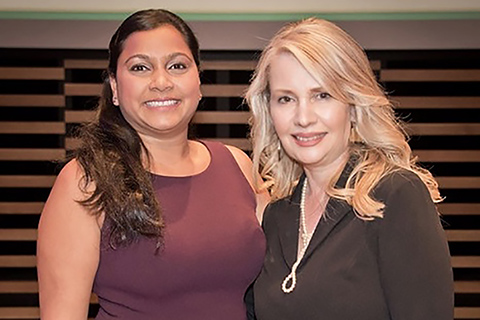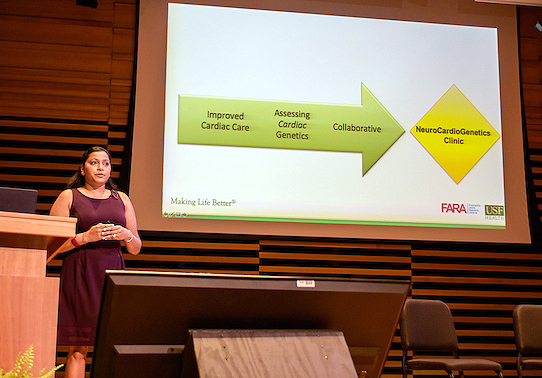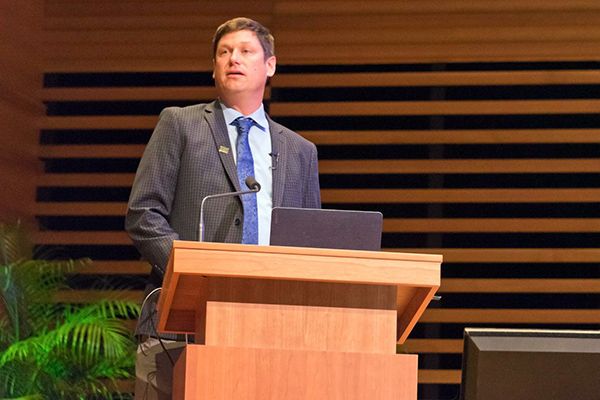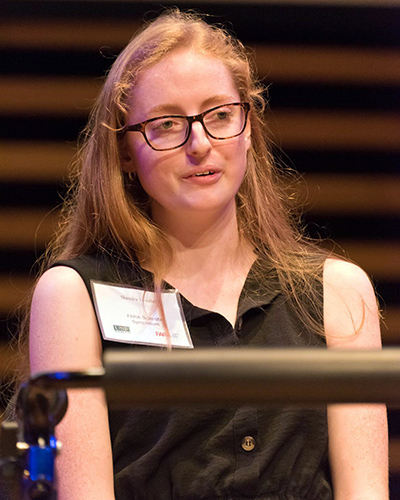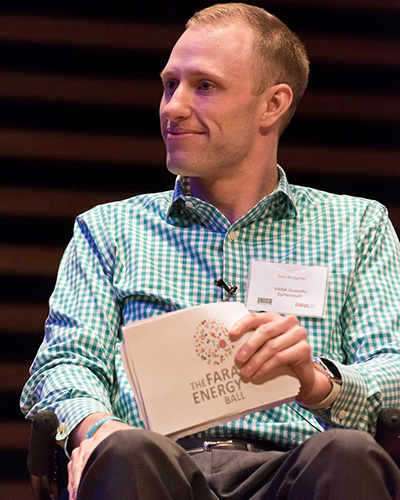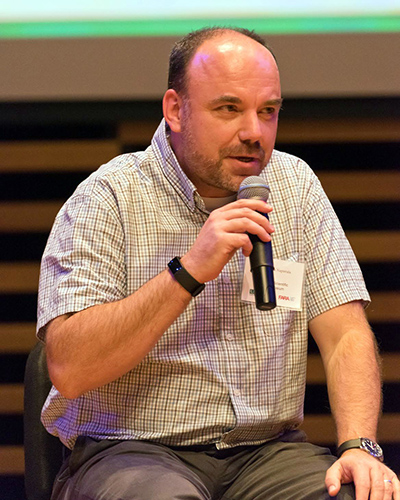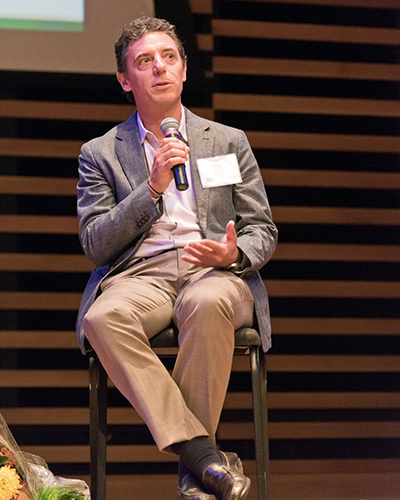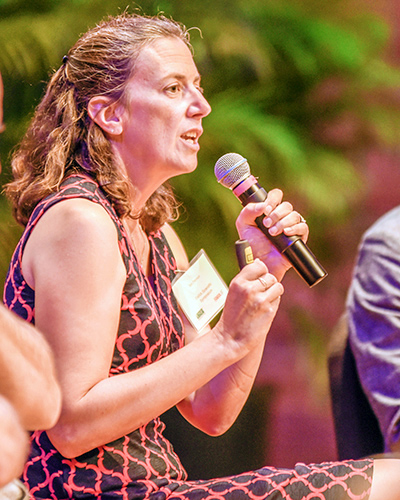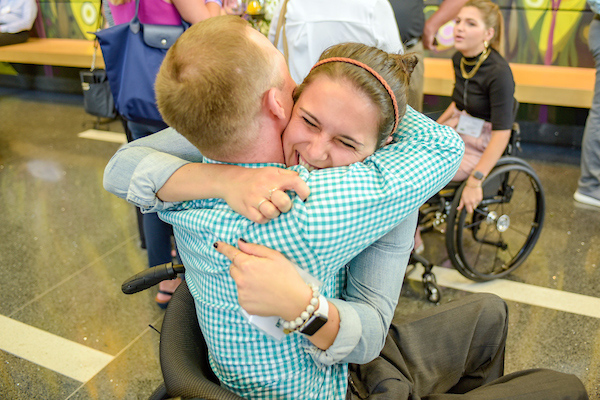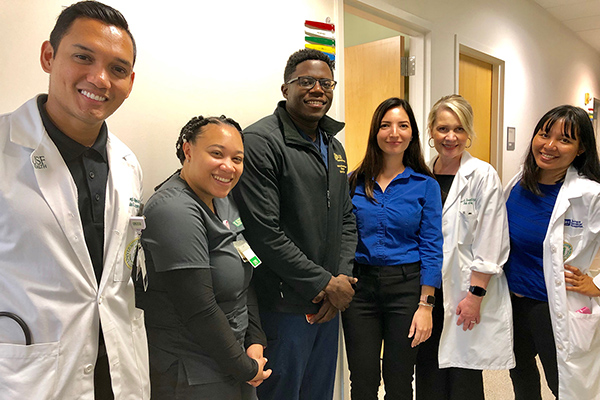The USF Health Ataxia Research Center was one of 11 sites in the Phase 2 clinical trial of omaveloxolone, which may prove key to the drug becoming the first targeted treatment for FA

Clifton Gooch, MD, professor and chair of the USF Health Morsani College of Medicine’s Department of Neurology, welcomes the audience to the symposium – those participating online as well as attending in person.
Less than three weeks after the 10th annual Friedreich’s Ataxia (FA) Scientific Symposium at USF, Reata Pharmaceuticals Inc. announced that its MOXIe trial of daily therapy with omaveloxolone capsules (RTA 408) improved the neurological function of patients with FA – a rare, debilitating and life-shortening neuromuscular disorder.
“It’s exciting news for the Friedreich’s ataxia community,” said Theresa Zesiewicz, MD, professor of neurology and director of the USF Health Ataxia Research Center, one of 11 sites for the international Phase 2 clinical trial testing the safety and effectiveness of omaveloxolone. “The MOXIe results move us a step closer to FDA approval of what may be the first urgently needed treatment for patients with FA.”
Reata announced on Oct. 14 that the investigational therapy met the randomized, placebo-controlled Phase 2 trial’s primary endpoint. Compared to placebo, daily treatment for 48 weeks with 150 mg of omaveloxolone (designed to help restore a damaged energy-producing pathway inside cells) demonstrated a 2.4-point improvement in mFARS, the modified Friedreich’s ataxia rating scale used to measure disease progression. Based on the strong positive results, Reata plans to seek approval from the FDA and regulatory agencies abroad for oxmaveloxolone to become the first targeted treatment for FA.
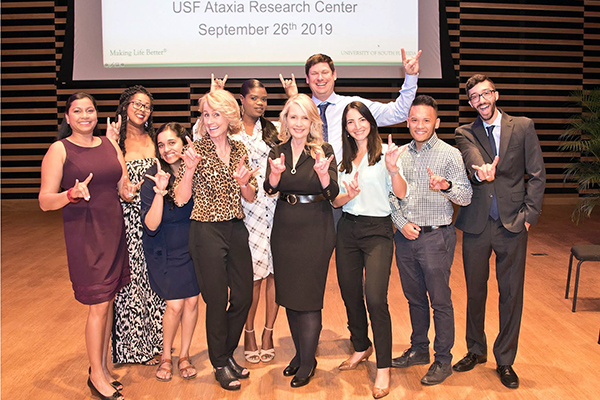
Theresa Zesiewicz, MD, (center) professor of neurology and director of the USF Health Ataxia Research Center, with some of the center’s staff and collaborators.
Hosted by the Friedreich’s Ataxia Research Alliance and the USF Health Ataxia Research Center, the scientific symposium was held Sept. 26 at the USF School of Music auditorium. The event brought together researchers, clinicians, industry partners, patient and caregivers – all who share a commitment to finding effective treatments and a cure for FA and related neuromuscular disorders. As one of 11 sites in the Friedreich’s Ataxia Collaborative Clinical Research Network, USF Health partners with FARA in working with government agencies, pharmaceutical companies, other research centers and the patient community to advance translational research, trials, and multidisciplinary clinical care for those living with FA.
FA is caused by mutations in the frataxin gene, ultimately resulting in a lack of the protein frataxin. This leads to impaired function of mitochondria (the cell’s energy-producing powerhouse needed to keep cells working properly), suppression of the transcription factor Nrf2 (known to protect against oxidative damage and help alleviate inflammation), neuroinflammation and neurodegeneration. Symptoms of FA, the most common inherited ataxia, include loss of arm and leg coordination, fatigue, vision and hearing loss, slurred speech, curvature of the spine, diabetes, and serious heart conditions including cardiomyopathy and arrhythmias.

The panel of patients shared firsthand their perspectives and experiences of living with Friedreich’s ataxia. From left: Panel moderator Susan Walther, FARA patient engagement director, with Shandra Trantham, Gainesville, FL; Brendan Halverson, Battle Creek, MI; Sam Bridgman, Seattle, WA; and Madelyn Frederick, Plano, TX.

The research panel on emerging therapies was moderated by Kyle Bryant (far right), founder and director of rideAtaxia, which has raised over $7 million for FA research since 2007.
At the symposium, Dr. Zesiewicz announced USF Health’s new Neurocardiogenetics Clinic teaming experts from neurology and cardiology. The multidisciplinary clinic has a translational research emphasis and focuses on improving the quality of life for FA patients, most of whom will develop cardiac complications during the course of the neuromuscular disease.
The year’s symposium was also marked by excitement over a new era in gene therapy, which holds promise for rare hereditary diseases including FA. Speakers addressed the potential benefits and challenges of delivering genes to targeted cells and applying the powerful gene-editing technology CRISPR to alter DNA and modify gene function.

Suzanne and Paul Avery, long-time friends of USF, were honored with a special presentation recognizing their dedication and generosity to finding a cure for FA.
The research momentum continued on Sept. 28 with the 2019 FARA Energy Ball, which benefits FARA and USF Health. This year’s event generated $1.6 million to add to the over $15 million previously raised to help fund drug discovery and development and clinical research.
Here’s a sampling of what the symposium speakers had to say:
Charles Lockwood, MD, senior vice president of USF Health and Morsani College of Medicine dean: “Today represents the collaborative effort of countless individuals and organizations committed to curing FA. I could not be more pleased with the strong relationship we’ve developed between FARA and the USF Health Ataxia Research Center.”
Theresa Zesiewicz, MD (right), professor of neurology and director, USF Health Ataxia Research Center (with USF Health cardiologist Aarti Patel, MD, left: “Because FA is a multisystem disease that affects may different parts of the body (including the heart), we need a multisystem approach to treatment.”
Aarti Patel, MD, assistant professor of cardiology and member of the new USF Health Neurocardiogenetics Clinic: “Our focus is on diagnosing cardiac problems very early, providing surveillance mechanisms and overall management so FA patients can live cardiac disease free.”
Matthew Lazinski, DPT, associate professor and director of the USF Health Physical Therapy Center: “The cornerstone of our physical therapy treatment is gait and mobility training. Our goal is to optimize the current function of patients to help avoid some deficits in mobility that occur with the progression of Friedreich’s ataxia.”
Paul Avery, long-time friend of USF and FARA Chairman of the Board: “USF has upped their game, and it’s really exciting how they continue to improve the intensity and effectiveness of fighting this disease.”
Shandra Trantham, 22, diagnosed with FA at age 12, is a USF graduate earning her PhD in genetics at the University of Florida: “Working toward a cure for FA became so much more personal for me when I met other people with the same disease. Then, it wasn’t just about me anymore; it was about my best friends.”
Sam Bridgman, 28, diagnosed with FA at age 15, completed an internship with the Tampa Bay Lightning while earning an MBA and master’s in sport and entertainment management at USF. He now works for NHL Seattle: “Impossible is nothing is my life motto… It’s a daily reminder that we can accomplish anything we set our minds to, and that extends to finding a cure for FA.”
Marek Napierala, PhD, associate professor of biochemistry and molecular genetics, University of Alabama at Birmingham: “In Friedreich’s ataxia patients the process of transcription of the frataxin gene is inhibited and that ultimately leads to less frataxin proteins… Our therapeutic goal is to increase the amount of frataxin protein. If we can figure out how to do that, we can cure Friedreich’s ataxia.”
Giovanni Manfredi, PhD, professor of neuroscience at Weill Cornell Medical College and FARA chief scientific officer: “The good news is that we do not need to increase frataxin all that much, because 50% of the normal level of frataxin protein is sufficient for normal mitochondrial function and a successful outcome… We can either replace the gene, or the protein, or the RNA process in between – but, of course, the devil is in the details of how we actually do that.”
Jennifer Farmer, FARA executive director: “We know we’re not going to be able to get the gene to every cell in the body (in need of more frataxin), But, if we target one area of the heart or the brain, can we achieve sufficient delivery of the gene to cells in the target region to make the necessary therapeutic impact? Gene therapy is exciting because of the magnitude of its potential benefit – but we also want to make sure that when we do it, we’ve got it right.”
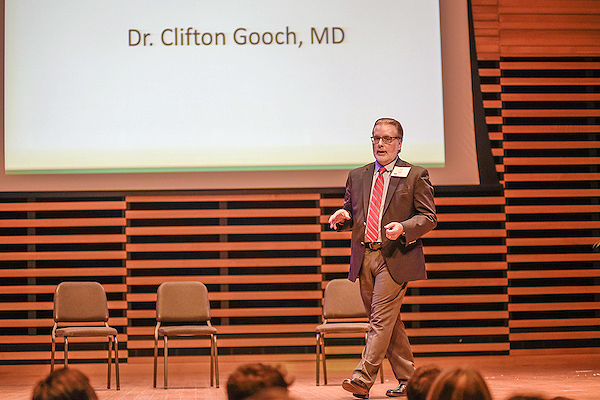
Clifton Gooch, MD, professor and chair of neurology, USF Health Morsani College of Medicine: “You, the patients, are our inspiration. We fight because we see your courage, your fortitude. We see your spirit of not giving up and making the best of everything you have… I don’t know when it will happen, but I believe we’re firmly on the path to conquering this disease. Given the advances in gene therapy and technology, it’s conceivable we could end this disease. And once we have the solution, FA will be no more.”
Photos by Freddie Coleman, USF Health Communications and Marketing, and Kent Ross
